移除链表元素
链接: 移除链表元素

/**
* Definition for singly-linked list.
* struct ListNode {
* int val;
* struct ListNode *next;
* };
*/
struct ListNode* removeElements(struct ListNode* head, int val)
{
//设置俩个指针
//prev用来记录val前面的指针
//假设将prev的指向head的前面,即为NULL
struct ListNode* prev = NULL;
//cur用来判断,cur指向链表第一个
struct ListNode* cur = head;
//利用prev和cur进行循环
//当cur为NULL停止
while(cur != NULL)
{
if(cur->val != val)
{
//cur的值不等于val时
//prev向后移动一步
//cur向后移动一步
prev = cur;
cur = cur->next;
}
else
{
//判断如果一个值为val时,此时prev任然为NULL;
//需要将这种cur向后移
if(prev == NULL)
{
//将head指向下一个
head = cur->next;
//释放cur
free(cur);
//cur重新指向head的值
cur = head;
}
else
{
//cur的值等于val时
//将prev指向的地址向后移动一步
prev->next = cur->next;
//释放cur所在的内存
free(cur);
//将粗人指向新的prev后面的位置
cur = prev->next;
}
}
}
return head;
}
链表的中间结点
链接: 链表的中间结点
思路:使用快慢指针进行解答
1.定义一个快指针和慢指针均指向头指针
2.快指针一次走俩步,慢指针一次走一步
3.当快指针为空指针或者快指针的下一个指针为空时结束
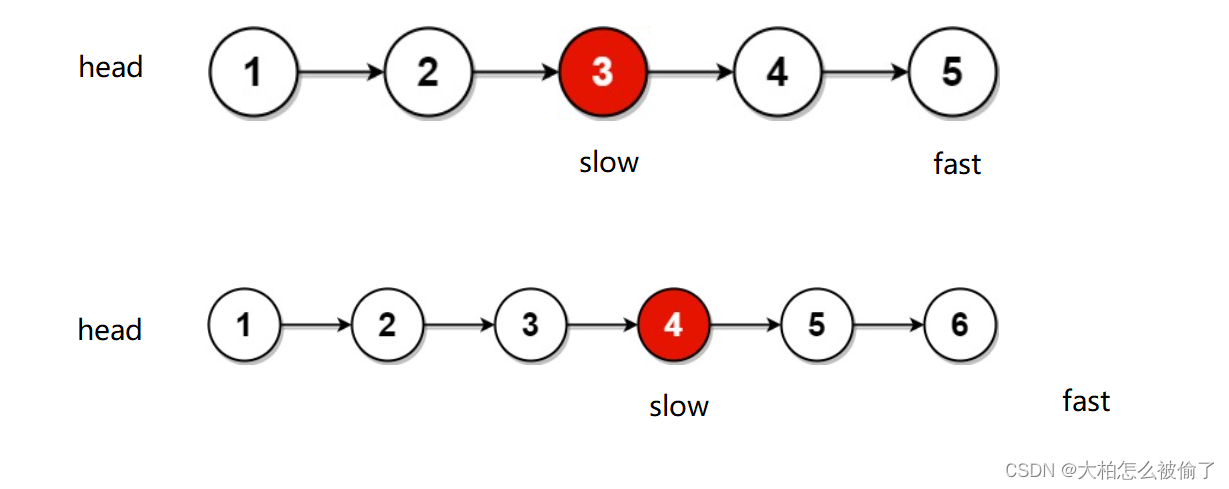
代码详解:
/**
* Definition for singly-linked list.
* struct ListNode {
* int val;
* struct ListNode *next;
* };
*/
struct ListNode* middleNode(struct ListNode* head)
{
//定义一个快指针,一次走俩格
struct ListNode* fast = head;
//定义一个慢指针,一次走一格
struct ListNode* slow = head;
while(fast != NULL && fast->next != NULL)
{
fast = fast->next->next;
slow = slow->next;
}
return slow;
}
返回倒数第k个结点
链接: 返回倒数第k个结点
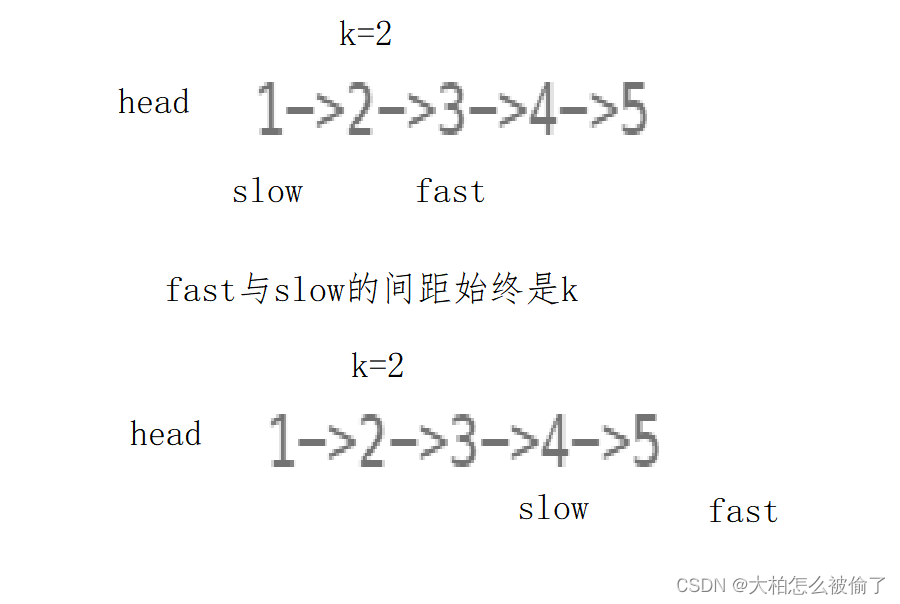
思路:使用先后指针解答
1.定义一个先走指针fast和慢走指针slow
2.先走指针要比慢走指针快k步
3.然后俩个指针同时进行移动
4.当先走指针遇到NULL时停止
/**
* Definition for singly-linked list.
* struct ListNode {
* int val;
* struct ListNode *next;
* };
*/
int kthToLast(struct ListNode* head, int k)
{
//定义一个先走指针,
struct ListNode* fast = head;
//定义一个慢走指针
struct ListNode* slow = head;
//先走指针比慢走指针快k步
while(k--)
{
fast = fast->next;
}
//俩个指针一起走
while(fast != NULL)
{
fast = fast->next;
slow = slow->next;
}
return slow->val;
}
合并俩个有序链表
链接:合并俩个有序链表
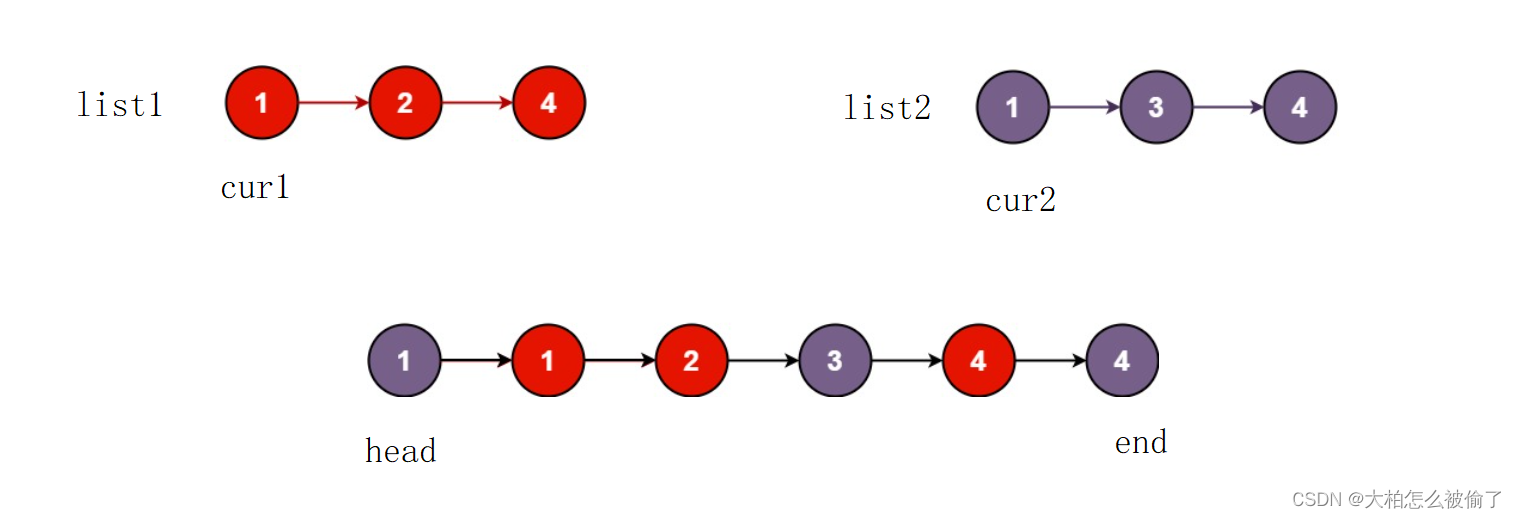
思路:
1.定义cur1指向list1的头结点,定义cur2指向list2的头结点,定义head和end指向空
2.cur1用来遍历list1,cur2用来遍历list2,head用来记录合并后的头结点,end用来记录合并后的尾结点,以确保可以向后添加结点
3.判断是否有空,但凡有一个为空,就可以返回另外一个;如果俩个都不为空,需要设置合并后的头结点head
4.当俩个都不为空,进入循环,向end后面接结点
5.当俩个中间有一个为空时,可以只在将另一个接在end后面
代码:
/**
* Definition for singly-linked list.
* struct ListNode {
* int val;
* struct ListNode *next;
* };
*/
struct ListNode* mergeTwoLists(struct ListNode* list1, struct ListNode* list2)
{
//设置四个结点
struct ListNode* cur1 = list1;
struct ListNode* cur2 = list2;
struct ListNode* head = NULL;
struct ListNode* end = NULL;
//判断如何都不为空
if (cur1 && cur2)
{
//将合并后头结点head指向小值
if (cur1->val < cur2->val)
{
head = end = cur1;
cur1 = cur1->next;
}
else
{
head = end = cur2;
cur2 = cur2->next;
}
}
//cur1与cur2都不为空所以不需要判断else,如果没有else,设置完头结点head后,有一个可能为空,导致返回。
else if (cur1 == NULL)//cur1为空,返回cur2
{
return cur2;
}
else if (cur2 == NULL)//cur2为空。返回cur1
{
return cur1;
}
//俩个都不为空进行插入链表
while (cur1 && cur2)
{
//每次插入都需要,将cur和end向后移动
if (cur1->val <= cur2->val)
{
end->next = cur1;
cur1 = cur1->next;
end = end->next;
}
else
{
end->next = cur2;
cur2 = cur2->next;
end = end->next;
}
}
//如果其中一个为空,可以直接将另一个后面的全部接在end后面
if (cur1 == NULL)
{
end->next = cur2;
}
if (cur2 == NULL)
{
end->next = cur1;
}
return head;
}
链表分割
链接:链表分割
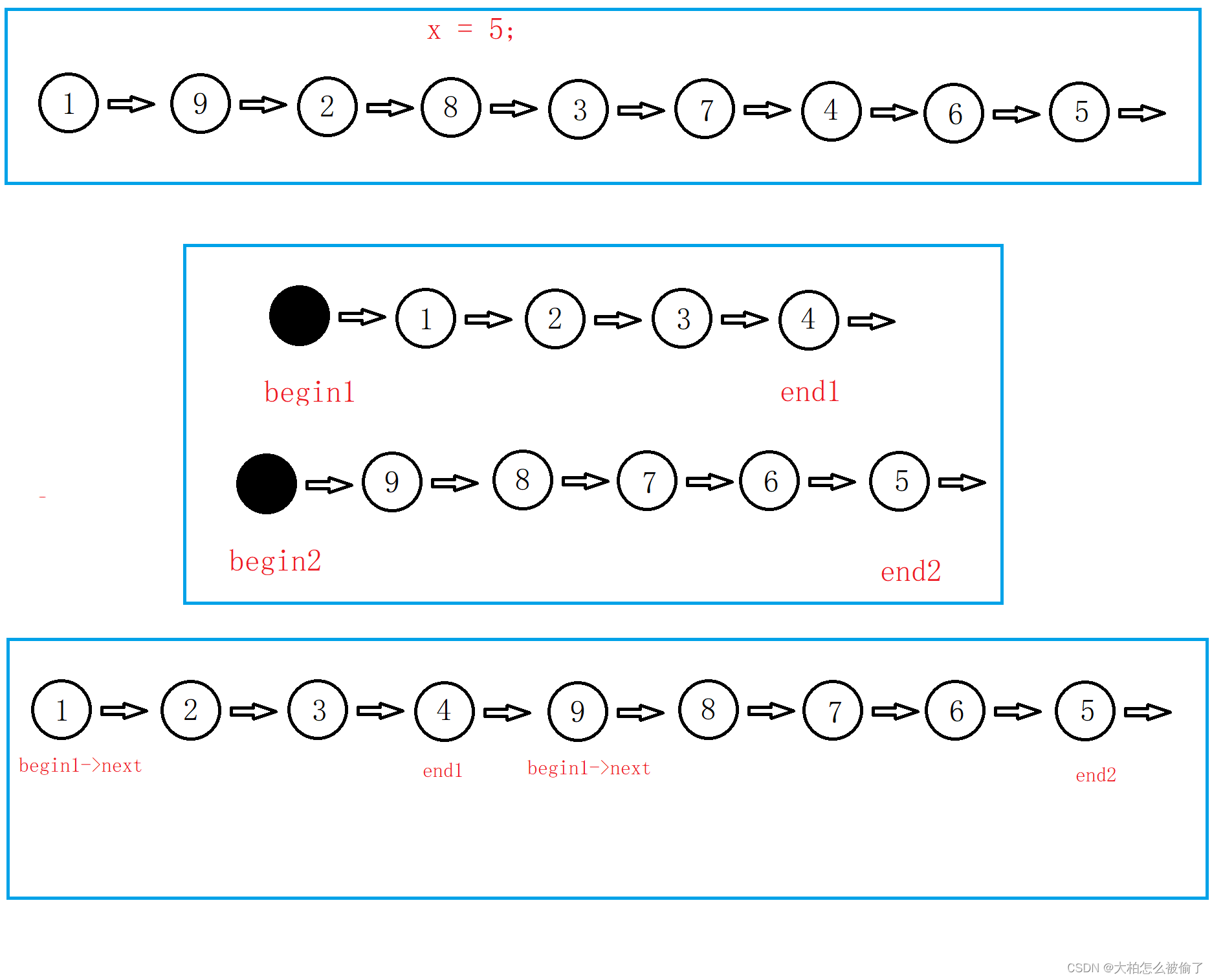
思路:
1.首先需要创建俩个哨兵结点来将大值结点与小结点分割开
2.使用四个指针指向俩个哨兵结点,begin1、begin2、end1、end2
3.begin1与begin2保留俩个哨兵结点的位置,end1与end2接后面的结点
4.然后将俩个哨兵结点相连,注意需要释放空间
/*
struct ListNode {
int val;
struct ListNode *next;
ListNode(int x) : val(x), next(NULL) {}
};*/
class Partition {
public:
ListNode* partition(ListNode* pHead, int x)
{
//创建俩个哨兵结点
//使用begin1与end1指向第一个哨兵
//使用begin2与end2指向第二个哨兵
struct ListNode* begin1;
struct ListNode* begin2;
struct ListNode* end1;
struct ListNode* end2;
begin1 = (struct ListNode*)malloc(sizeof(struct ListNode));
begin2 = (struct ListNode*)malloc(sizeof(struct ListNode));
if(begin1 == NULL || begin2 == NULL)
{
perror("malloc fail");
return NULL;
}
begin1->next = NULL;
begin2->next = NULL;
end1 = begin1;
end2 = begin2;
//将小于x的结点接在begin1后面
//将大于等于x的结点接在begin2后面
while(pHead != NULL)
{
if(pHead->val < x)
{
end1->next = pHead;
end1 = end1->next;
}
else
{
end2->next = pHead;
end2 = end2->next;
}
pHead = pHead->next;
}
//将end1与end2后面置空
end1->next = NULL;
end2->next = NULL;
//将大于等于x的结点接在小于x的结点后面
end1->next = begin2->next;
//将小于x的第一个结点设置为头结点
pHead = begin1->next;
//注意需要释放malloc创建的堆区已经野指针问题
free(begin1);
free(begin2);
begin1 = begin2 = end1 = end2 = NULL;
return pHead;
}
};
相交链表
链接: 相交链表
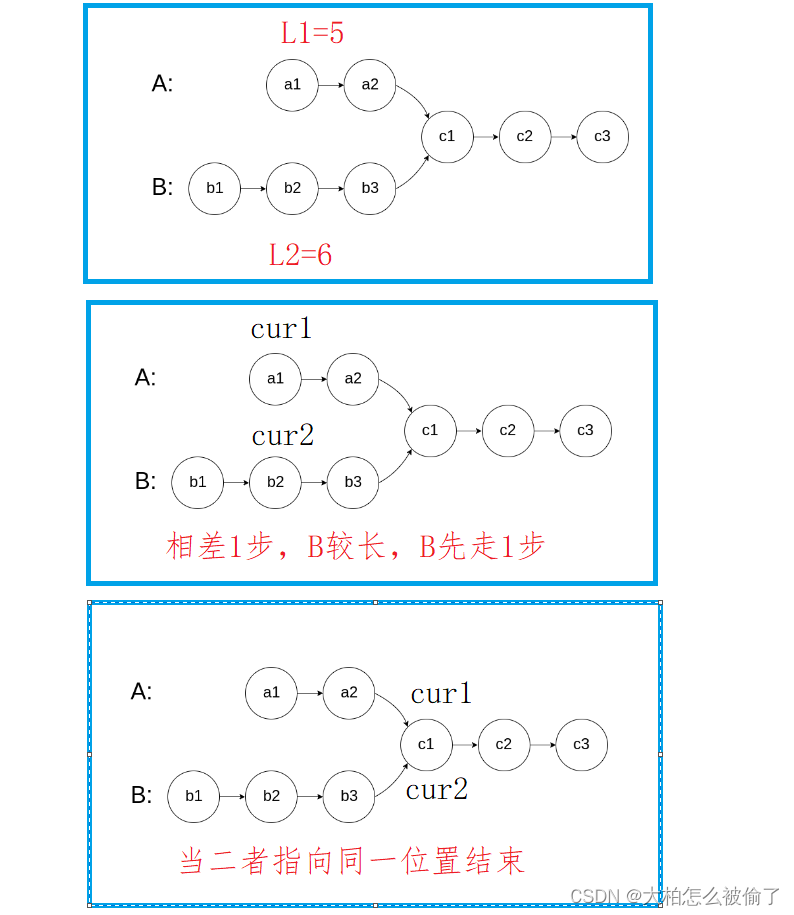
思路:
1.定义俩个指向链表的指针和俩个计算结点个数(长度)的变量
2.求出俩个链表有几个结点,即链表的长度
3.如果最后一个结点处,二者并没有相交,则返回NULL
4.将俩个链表的结点个数(长度)相减,让结点个数(长度)多(长)的先走相减的个数。
5.最后俩条链表同时走,遇到相同结点时结束
/**
* Definition for singly-linked list.
* struct ListNode {
* int val;
* struct ListNode *next;
* };
*/
struct ListNode *getIntersectionNode(struct ListNode *headA, struct ListNode *headB)
{
//设置L1和L2计算俩条链的长度
int L1 = 1, L2 = 1;
//设置俩个指针指向俩条链的头结点
struct ListNode* cur1 = headA;
struct ListNode* cur2 = headB;
//计算L1的长度
while(cur1->next != NULL)
{
cur1 = cur1->next;
++L1;
}
//计算L2的长度
while(cur2->next != NULL)
{
cur2 = cur2->next;
++L2;
}
//判断如果俩个直接的最好交点不在一起则直接返回NULL
if(cur1 != cur2)
{
return NULL;
}
//计算链的长度差
int L = L1 - L2;
//将移动的指针重新指向头结点
cur1 = headA;
cur2 = headB;
//让长度较长的指针先走L步
if(L > 0)
{
while(L--)
{
cur1 = cur1->next;
}
}
else
{
while(L++)
{
cur2 = cur2->next;
}
}
//俩个指针同时走,发现相同时停止
while(cur1 != cur2)
{
cur1 = cur1->next;
cur2 = cur2->next;
}
return cur1;
}
环形链表
链接: 环形链表
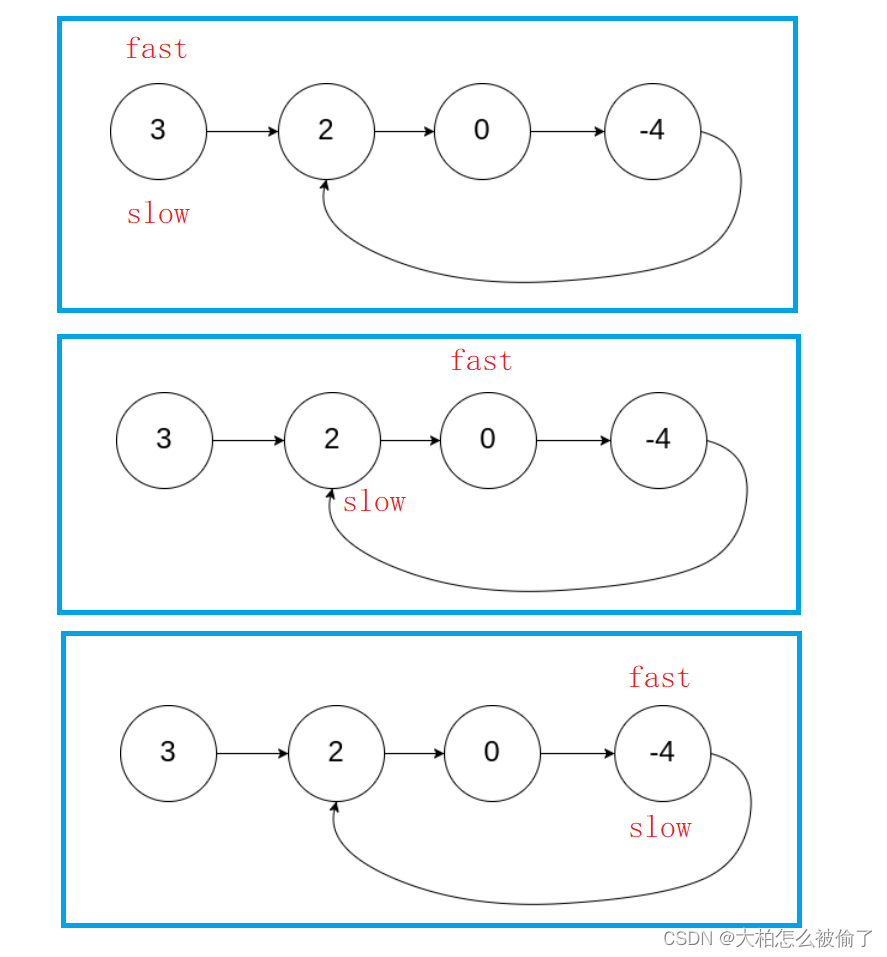
思路:
1.判断是否存在空结点和只有一个结点的情况
2.定义一个快结点和一个慢结点
3.快结点一次走俩步,慢结点一次走一步
4.当二者相遇时结束
/**
* Definition for singly-linked list.
* struct ListNode {
* int val;
* struct ListNode *next;
* };
*/
bool hasCycle(struct ListNode *head)
{
//判断是否存在空链表或者链表中只存在一个结点
if(head == NULL || head->next == NULL)
{
return false;
}
//定义一个快结点和慢结点
struct ListNode* fast = head;
struct ListNode* slow = head;
//快结点一次走俩步
//慢结点一次走一步
while(fast != NULL && fast->next != NULL)
{
fast = fast->next->next;
slow = slow->next;
//相遇时结束
if(fast == slow)
{
return true;
}
}
return false;
}
链表的回文结构
链接: 链表的回文结构

思路:
1.判断当存在空链表或者当个链表时返回true
2.设置快慢指针求得中间结点
3.使用三个指针翻转后半段链表
4.使用一前一后俩个指针判断是否为回文结构
难点:使用三个指针翻转链表时,循环停止的条件为中间的指针为空,此时需要第三个结点在循环内初始化,这样才能保证后面每一个链表都能翻转过来,并且当第三个结点为空时,不会执行next
- 代码实现:
/*
struct ListNode {
int val;
struct ListNode *next;
ListNode(int x) : val(x), next(NULL) {}
};*/
class PalindromeList {
public:
bool chkPalindrome(ListNode* A)
{
//链表为空或者链表只有一个返回true
if(A == NULL || A->next == NULL)
{
return true;
}
//设置快慢指针
//快指针一次走俩步
//慢指针一次走一步
struct ListNode* fast = A;
struct ListNode* slow = A;
//寻找中间结点
while(fast != NULL && fast->next != NULL)
{
fast = fast->next->next;
slow = slow->next;
}
//slow此时所在位置为中间结点
//从中间结点往后开始翻转链表
struct ListNode* cur = slow->next;
while(cur != NULL)
{
struct ListNode* cur_next = cur->next;
cur->next = slow;
slow = cur;
cur = cur_next;
}
//设置一个头结点和尾结点
struct ListNode* tail = slow;
struct ListNode* head = A;
//一前一后开始比较
//比较正确,比较下一个
//比较错误,返回错误
while( head != tail)//奇数时二者相遇
{
if(head->val != tail->val)
{
return false;
}
if(head->next == tail)
{
//偶数时head的下一个是tail
return true;
}
head = head->next;
tail = tail->next;
}
return true;
}
};























 被折叠的 条评论
为什么被折叠?
被折叠的 条评论
为什么被折叠?








